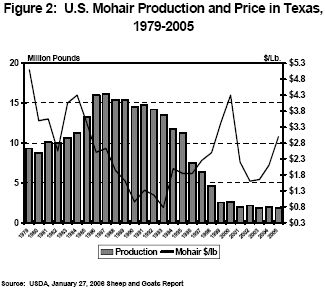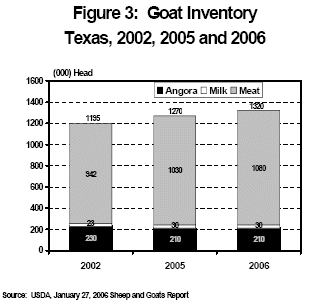AG-ECO NEWS
Vol. 22, Issue 05, March 07, 2006
Jose G. Peña
Extension Economist-Management
Total U.S. Goat Inventory Up Slightly;
Angora Goat Inventory Down Slightly
While the total U.S. all-goat inventory increased 4.1 and 11.7 percent from 2005 and 2002 respectively, the size of the Angora goat herd decreased 0.7 and 7.6 percent, respectively. When comparing inventory changes during the past two years to the previous 12 years, however, it appears that the liquidation of the U.S. Angora goat herd may be slowing down. Price bids for Angora kids and mohair have improved recently and may be influencing the slow-down of the liquidation of the U.S. Angora goat inventory.
The mix between Angora, meat and milk goats has changed dramatically during the last 14 years. While the size of the U.S. Angora goat herd on January 1, 2006 is only 14.7 percent of the 1.9 million head Angora goat herd in 1992, it appears that Angora goats have been replaced with meat goats at more than a one for-one-basis. USDA’s January 27, 2006 Sheep and Goat report indicates that the U.S. goat inventory has continued to increase. (See Figure 1). The size the total U.S. goat herd is now larger than the size of the U.S. goat herd in 1992. Meat goats now comprise about 80 percent of the U.S. goat herd, compared to Angora goats which accounted for more than 90 percent of the total U.S. goat herd in 1992.

Mohair Production/Prices Up
While mohair production dropped to 1.88 million pounds in 2003, the lowest production since 1987, mohair production increased slightly in 2004, but decreased to 1.822 million pounds during 2005, down 132,000 pounds from 1.954 million pounds produced in 2004. Prices, however, have improved. After dropping to record lows during the mid-90’s, prices for mohair made an excellent recovery in 2000, weakened during 2002 but have been showing strength during the past three years. (See Figure 2).

Improved prices for mohair, record high prices for kids which are averaging $1.45/lb for 40-60 lbs slaughter meat goat kids, for example, and the new loan deficiency payment program for mohair appear to be helping to stabilize the industry. Keep in mind that replacement Angora does are in high demand and there is very limited availability.
Most of the mohair is being exported. The weakening of the U.S. dollar in terms of exchange rates during the past few years made U.S. commodities, such as mohair, less expensive to foreign importers and encouraged exports. The recent strengthening of the U.S. dollar may slow down exports. Since there is limited domestic use, reduced export demand may be translated into lower prices. Currently, the industry is being supported by a substantial accumulation of stocks stored in warehouses. About three times the amount of the current annual production is being exported to countries like South Africa and the United Kingdom with the excess of production coming out of warehouse stocks. For example, 3.349 million pounds (clean) were exported primarily to South Africa (58% of exports), the United Kingdom (23% of exports) and five other countries in 2004, when U.S. production was estimated at 1.954 million pounds (greasy). What will happen to the industry when stocks are depleted?
Texas Leading State
Texas dominates the U.S. commercial goat industry with about 47 percent of the U.S. inventory. (See Figure 3).

Texas continues to dominate the mohair industry with 75.5 percent of the U.S. herd, followed by Arizona with 9.2 percent and New Mexico with 3.6 percent.
